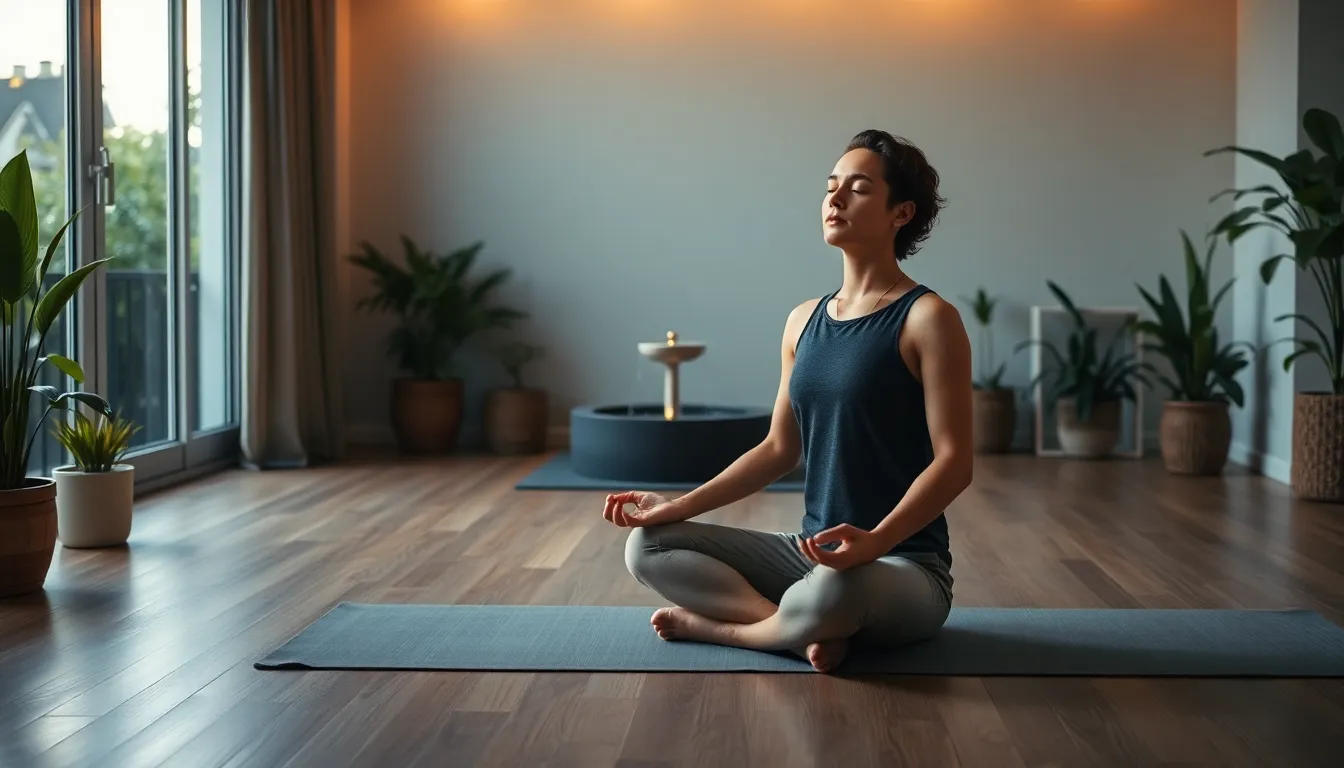In a fast-paced world filled with distractions, meditation offers a sanctuary for the mind and soul. It’s a practice that transcends cultures and centuries, providing individuals with a path to inner peace and clarity. As more people seek to enhance their mental well-being, meditation guides have emerged as essential tools to navigate this transformative journey.
Whether you’re a beginner or a seasoned practitioner, the right meditation guide can elevate your experience, helping you cultivate mindfulness and reduce stress. From simple breathing techniques to advanced visualization practices, these guides cater to diverse needs and preferences. By incorporating meditation into daily routines, individuals can unlock a deeper connection with themselves and the world around them.
Table of Contents
ToggleOverview of Meditation Guides
Meditation guides provide structured approaches to meditation, making the practice accessible and effective. These resources often include step-by-step instructions, tips for improving focus, and insights on common challenges.
Types of Meditation Guides
- Books: Authors like Jon Kabat-Zinn and Thich Nhat Hanh offer comprehensive insights and methods.
- Apps: Popular platforms such as Headspace and Calm deliver guided sessions for varied experience levels.
- Online Courses: Websites like Udemy and Coursera feature courses ranging from beginner techniques to advanced practices.
Techniques Covered
- Breathing Exercises: Guides often focus on diaphragmatic breathing to cultivate awareness.
- Mindfulness Practices: Many emphasize being present in the moment through noticing thoughts and sensations.
- Visualization Methods: Some guides explore imaginative techniques, enhancing relaxation and focus.
Benefits of Using Meditation Guides
- Structured Learning: Guides provide a roadmap for newcomers navigating meditation concepts.
- Variety of Techniques: They expose users to numerous methods, allowing a personalized approach.
- Consistency: Regularly following a guide fosters discipline in practice, leading to better results.
Target Audiences
- Beginners: Individuals new to meditation gain foundational knowledge and simple practices.
- Intermediate Practitioners: Those with some experience deepen their understanding and refine techniques.
- Advanced Users: Experienced practitioners find inspiration through advanced methods and new perspectives.
Meditation guides serve as instrumental tools for fostering a consistent and enriching meditation practice.
Types of Meditation Guides

Meditation guides come in various formats, catering to different preferences and learning styles. Each type offers unique benefits for practitioners at all levels.
Written Guides
Written guides, including books and articles, provide comprehensive instruction on meditation techniques. These resources often explore foundational topics such as mindfulness, breathing exercises, and visualization methods. Notable authors like Jon Kabat-Zinn and Sharon Salzberg offer insights in texts that combine theory with practice. Written guides allow for in-depth exploration and personal reflection, making them suitable for individuals who prefer a self-paced approach to learning.
Audio Guides
Audio guides deliver meditation instructions through recordings, allowing users to practice hands-free. These guides often include guided meditations, ambient sounds, and music designed to facilitate relaxation. Platforms like Insight Timer and apps like Headspace feature a wide array of audio content, catering to different meditation styles and lengths. Audio guides are ideal for those who benefit from verbal cues and find it easier to focus while listening rather than reading.
Video Guides
Video guides provide a visual component to meditation practice, showcasing techniques and settings. They often include demonstrations, scenic backdrops, and instructor-led sessions which enhance engagement. YouTube and dedicated meditation apps, such as Calm, host thousands of video resources covering various practices, from yoga nidra to transcendental meditation. Video guides suit individuals who prefer visual learning and seek a more interactive experience in their meditation journey.
Benefits of Using Meditation Guides
Using meditation guides offers several benefits that enhance the meditation experience.
- Structured Learning: Meditation guides provide a step-by-step approach. They break down techniques into manageable segments, making it easier for individuals to understand and implement practices effectively.
- Diverse Techniques: Guides expose practitioners to a variety of meditation methods. From mindfulness to visualization, these resources enable users to explore different styles, helping them find the techniques that resonate with their personal preferences.
- Consistency: Meditation guides encourage regular practice. By establishing a routine, individuals develop a habit that fosters greater mindfulness and deeper relaxation over time.
- Accessibility: Many meditation guides come in various formats, such as books, audio, and video. This accessibility allows users to choose the medium that best suits their learning style, promoting a more engaging discipleship.
- Expert Insight: Guides often feature techniques from credible authors and instructors. Access to expert knowledge enhances the quality of practice, offering insights that may not be available through informal resources.
- Motivation: Following a structured guide can provide motivation and inspiration. Regularly engaging with new techniques and challenges encourages practitioners to persist in their meditation journey.
- Goal Orientation: Many guides include specific goals and outcomes. This focus helps individuals set intentions for their practice, leading to a more rewarding and purpose-driven meditation experience.
Incorporating meditation guides into one’s practice can lead to significant improvements in mental clarity, emotional well-being, and overall quality of life.
How to Choose the Right Meditation Guide
Selecting an appropriate meditation guide involves assessing personal experience levels and specific goals. A well-chosen guide enhances the meditation experience and promotes effective practice.
Consider Your Experience Level
Individuals should evaluate their meditation experience before choosing a guide. Beginners benefit from introductory guides that cover fundamental techniques and concepts. Such guides often include simple breathing exercises and basic mindfulness practices. Intermediate practitioners may look for guides that introduce specific techniques or deeper explorations of mindfulness, such as concentration practices or loving-kindness meditation. Advanced users typically seek out specialized guides that address nuanced topics, such as chakra meditations or advanced visualization techniques.
Identify Your Goals
Understanding personal meditation goals is crucial in selecting the right guide. Those aiming to reduce stress might favor guides focused on relaxation techniques or mindful breathing. Users looking to cultivate deeper self-awareness may benefit from mindfulness meditations that emphasize present-moment awareness. For individuals interested in enhancing emotional well-being, guides incorporating self-compassion practices or gratitude exercises serve as good choices. Clear goals help narrow down options and ensure the selected guide aligns with intended outcomes.
Popular Meditation Guides to Explore
Various meditation guides cater to diverse needs and preferences. Below are some popular options worth exploring:
Books
- “The Miracle of Mindfulness” by Thich Nhat Hanh: This guide emphasizes practical exercises and insights into mindfulness.
- “Wherever You Go, There You Are” by Jon Kabat-Zinn: This book provides a foundational understanding of mindfulness meditation.
- “The Mindful Way Through Depression” by Mark Williams: This resource utilizes mindfulness techniques to address emotional challenges.
Apps
- Headspace: A user-friendly app offering guided meditations for different topics, including stress and sleep.
- Calm: This app includes meditation sessions, soothing sounds, and sleep stories to enhance relaxation.
- Insight Timer: A diverse platform featuring thousands of free guided meditations, music tracks, and community features.
Online Courses
- Coursera’s “Mindfulness Meditation for Wellbeing and Personal Growth”: An accessible course for anyone looking to deepen their mindfulness practice.
- Mindful Schools: This organization offers structured programs designed for parents, educators, and children.
- Udemy’s “Meditation for Beginners”: An introductory course that walks users through essential meditation techniques and practices.
YouTube Channels
- The Honest Guys: This channel features meditations and guided imagery sessions aimed at relaxation and stress relief.
- Jason Stephenson: Known for his soothing voice, his guided sessions focus on mindfulness and deep relaxation.
- Tara Brach: This renowned meditation teacher offers a variety of meditative practices that emphasize compassion and acceptance.
Social Media
- Instagram: Various accounts like @meditationmama provide daily doses of mindfulness tips and short guided sessions.
- Facebook Groups: Numerous groups focus on meditation practices, allowing users to share experiences and resources.
By exploring these popular meditation guides, individuals can enhance their practice, foster mindfulness, and cultivate well-being across various aspects of life.
Meditation guides play a crucial role in enhancing one’s mindfulness journey. They provide tailored techniques that cater to different experience levels and personal goals. By exploring various formats such as books apps and online courses individuals can find the right resources to support their practice.
These guides not only foster consistency but also help users connect more deeply with themselves. As meditation continues to gain traction in today’s hectic world utilizing these resources can lead to significant improvements in mental clarity and emotional well-being. Embracing a meditation guide can be the first step toward a more balanced and fulfilling life.




